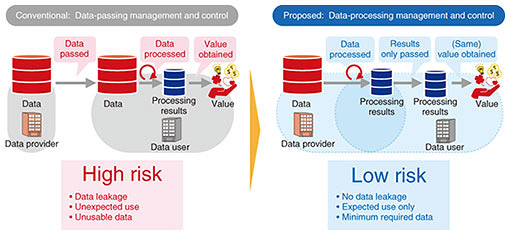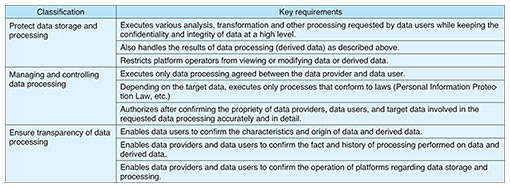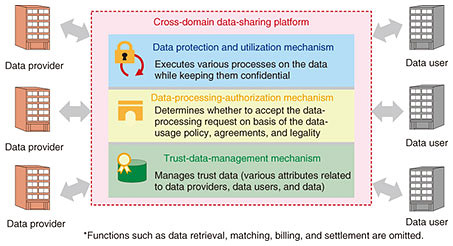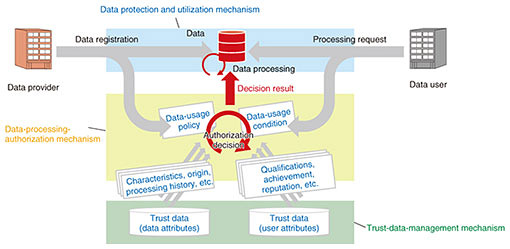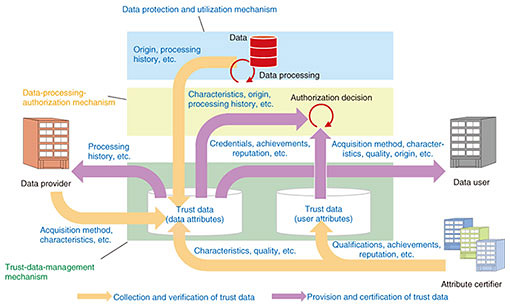 |
|||||||||||||
|
|
|||||||||||||
|
Feature Articles: Encryption and Security Technologies for Creating a Safe and Secure Society Vol. 19, No. 6, pp. 75–80, June 2021. https://doi.org/10.53829/ntr202106fa12 Data Sharing and Utilization Technologies for Safe and Secure Value-creation ProcessesAbstractTo achieve Society 5.0, a vision of a future society that achieves both economic development and resolution of social issues, it is essential to use data across organizations and industries, but this is not as widespread as it should be. This article outlines the risks associated with data utilization and their causes and introduces a new paradigm of data sharing and the platform and key technologies to achieve it. Keywords: data sharing, security, trust 1. Society 5.0 and cross-domain data sharingThe Japanese government proposed “Society 5.0,” as a vision of the future society that achieves both economic development and resolution of social issues [1], and efforts to achieve it are actively being made. In Society 5.0, cyberspace and the physical space will be highly integrated, and by making full use of various data, it will become possible to understand the situation at that time, discover issues, predict the future, and derive optimal solutions, which will lead to economic development and solve social problems. In other words, the success of Society 5.0 depends on how much data across organizations and industries (i.e., cross-domain data sharing) can be used. 2. Barriers to cross-domain data sharing and its causesHowever, cross-domain data sharing, especially the sharing of sensitive and rare data, has not progressed as much as expected. The largest barrier is the risk to both the data provider and data user. Data providers take the risk that the data they provide may be leaked or used in an unexpected way, causing damage to themselves or others. Data users, on the other hand, take the risks associated with confidentiality management of the data provided and the risks associated with the legality of such data. From another perspective, data users take the risk that the data they receive will not produce the desired results or value or may not meet the conditions imposed for receiving the data (for example, the payment for receiving the data). Data providers take the risk that the data they provide will create more value than expected (i.e, the payment they receive is undervalued) or may not fulfill the purpose of providing data for the data provider (for example, not receiving the obtained results from data utilization) when the expected results are not obtained. The root cause of the above risks is that traditional methods of data sharing involve passing on or receiving the data. Data can create different values and problems depending on how the data are used; therefore, it is difficult to determine all values and problems beforehand. With all this uncertainty, cross-domain data sharing cannot be actively carried out. 3. Toward a new paradigm of data-processing management and controlTo solve this problem, it is necessary to shift from the conventional to a new paradigm of data-processing management and control. In this new paradigm, on the basis of the principle of data minimization, data users are only given the results of agreed processing (the processing data users request and the processing data providers approve) of the data, not the original data. By doing this, the value and problems that can arise from the use of those data are limited and predictable, and the risks mentioned above are greatly reduced (Fig. 1).
4. Overview of cross-domain data-sharing platformOur goal is to create a trustworthy*1 cross-domain data-sharing platform based on the above new paradigm so that all data providers and data users participating in the platform can share and use all data with confidence. The platform’s three main requirements are (1) to be able to execute the necessary processing for the purpose while protecting the data, (2) to be able to control the processing of the data in accordance with the agreements and laws between the data provider and data user, and (3) to be transparent and accountable about the data handled and their processing (Table 1).
We believe the platform should consist of the following three mechanisms (Fig. 2):
(1) Data protection and utilization mechanism
(2) Data-processing-authorization mechanism
(3) Trust-data-management mechanism
5. Key technologies for cross-domain data sharingThe following is an overview of the key technologies for implementing the above mechanisms. 5.1 Secure computationSecure computation is a technology that enables computation while keeping data encrypted. This enables secure use of sensitive data such as personal data or corporate trade secrets. It also should enable the analysis of such data to extract new value by increasing the types and amounts of data to be analyzed. In secure computation technology, not only safety but also performance and diversity of processing are important. NTT Secure Platform Laboratories developed a secure computation system with the world’s fastest statistical processing [2]. We are currently developing secure computation artificial intelligence (AI) technology for executing learning and prediction processing in deep learning while keeping the input data and neural networks encrypted [3]. We are also working on increasing the speed of processing and expansion of the AI algorithms needed to process large amounts of data such as high-definition images. 5.2 Enhancing confidentiality and authenticity when data processingBecause cross-domain data sharing processes data in a variety of stakeholder computing environments, it is not easy to ensure data access control (ensuring confidentiality) or the authenticity of data-processing results. However, as mentioned above, cross-domain data-sharing platforms must meet these requirements to be trusted and widely used. Specifically, we believe the following two requirements are particularly important: (1) the data provider can check whether the provided data are being used only within the permitted operations and (2) the data user can check whether the data-processing results are correct as requested. 5.3 Attribute-based authorizationBecause large amounts of data are registered continuously on the platform and it is not known in advance who is going to use the registered data, attribute-based authorization is effective for cross-domain data sharing. Regarding attribute-based authorization, data-usage policies are defined in the form of conditions for what kind of subject can use what kind of data using the attributes of the subject and data. When authorization decisions are made, the attribute values of the data users and target data are applied to the conditions and evaluated. For example, a data user’s qualification (e.g., Information Security Management Systems Certification) is specified as a required attribute in the data-usage policy. Attribute-based authorization is not a new concept, but there are technical challenges when applying it to cross-domain data sharing. To make authorization decisions that take legality into account, it is necessary to check and determine the existence or value of specified attributes in accordance with the characteristics of the data, regardless of the data-usage policy, as described later. To avoid making an incorrect authorization decision, it is necessary to strictly determine the existence of the attribute specified in the data-usage policy and its authenticity (whether it has been certified by a third-party organization, etc.). It is also necessary to have flexibility in authorization decisions, such as conditionally allowing data usage in addition to permitting or prohibiting it. For example, the requested data may not be used as is but may be used after being anonymized. We believe that making flexible authorization decisions while coordinating the requirements of both data providers and data users will contribute to expanding data-sharing opportunities (Fig. 3).
5.4 Trust-data managementThe trust-data-management mechanism collects and manages attributes of platform users (qualifications, achievements, reputation, etc.) and attributes of data processed on the platform (data characteristics such as type, items, collection method, origin, and processing history). It then provides them to the data-processing-authorization mechanism, data providers, and data users as “trust data” that can be relied on when users and data are confirmed (Fig. 4).
Because trust data are the basis of trust, it is necessary to be able to verify that such data have been guaranteed by various entities regarding the data’s authenticity and correctness. However, trust data may be confidential; thus, it is necessary to appropriately determine when, to whom, and to what extent to disclose trust data. It is also required for the data to be available whenever needed. We will develop trust-data-management technologies and mechanisms that meet these various requirements. 5.5 Implementing legal requirements for trust data and authorization decisionsData providers and data users must also consider the legality of the data they share. It is difficult for data users to understand how the data were obtained and might not notice that illegally obtained data were included. The Act on the Protection of Personal Information prohibits the use of data that constitute personal information outside the scope of the purpose of use indicated to the person at the time of acquisition and the provision of such data to third parties without the person’s consent. To reduce the burden of legal compliance, we are studying a method of assigning attribute data that implements legal requirements together with data, managing the data as trust data, and checking the data when making authorization decisions. 6. For the futureWe believe that a trustworthy cross-domain data-sharing platform will accelerate collaboration and co-creation among the same or different industries, which were previously difficult, and enable the creation of new value and resolution of major social issues such as those regarding food, health, and the environment. To achieve this, we will accelerate not only research and development of key technologies but also proof of concept in cooperation with partners aiming at cross-domain data sharing, international standardization, and activities to foster social acceptability. References
|
|||||||||||||









